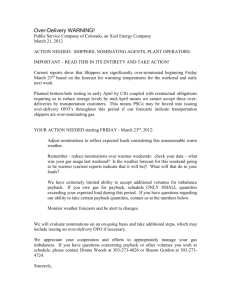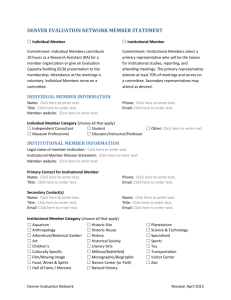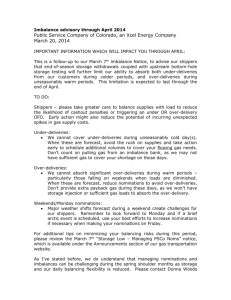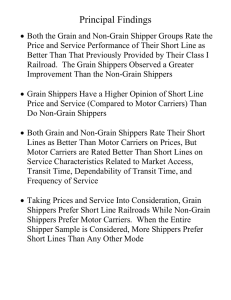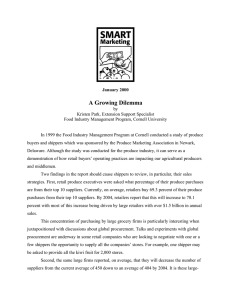Load Forecasting Tips - Xcel Energy
advertisement
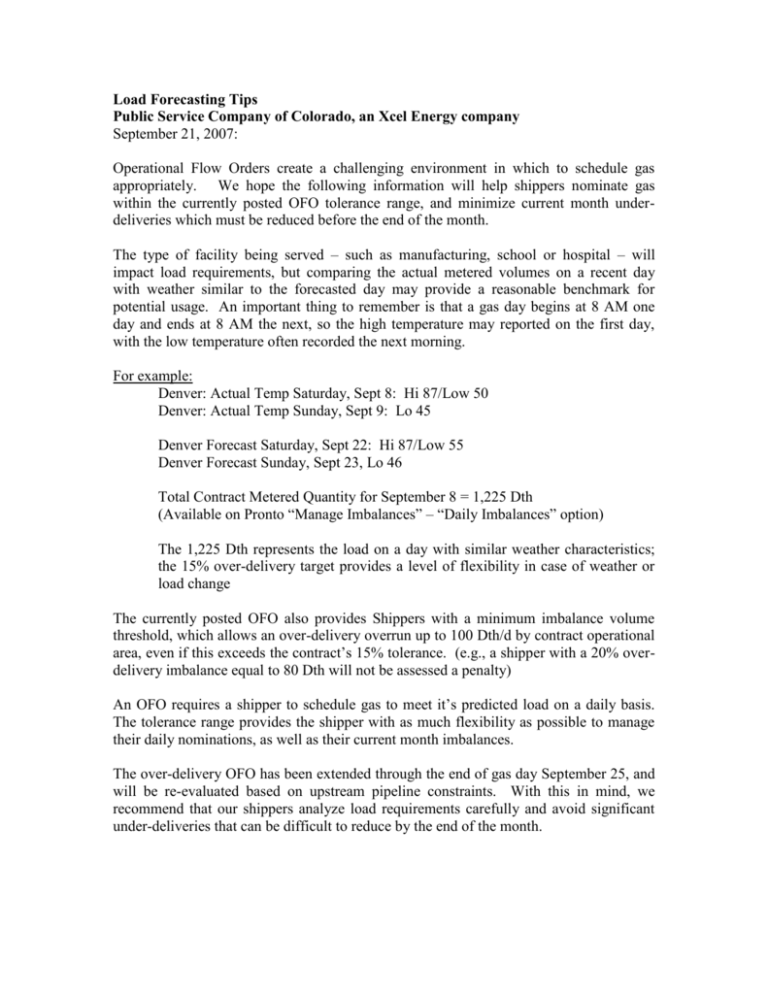
Load Forecasting Tips Public Service Company of Colorado, an Xcel Energy company September 21, 2007: Operational Flow Orders create a challenging environment in which to schedule gas appropriately. We hope the following information will help shippers nominate gas within the currently posted OFO tolerance range, and minimize current month underdeliveries which must be reduced before the end of the month. The type of facility being served – such as manufacturing, school or hospital – will impact load requirements, but comparing the actual metered volumes on a recent day with weather similar to the forecasted day may provide a reasonable benchmark for potential usage. An important thing to remember is that a gas day begins at 8 AM one day and ends at 8 AM the next, so the high temperature may reported on the first day, with the low temperature often recorded the next morning. For example: Denver: Actual Temp Saturday, Sept 8: Hi 87/Low 50 Denver: Actual Temp Sunday, Sept 9: Lo 45 Denver Forecast Saturday, Sept 22: Hi 87/Low 55 Denver Forecast Sunday, Sept 23, Lo 46 Total Contract Metered Quantity for September 8 = 1,225 Dth (Available on Pronto “Manage Imbalances” – “Daily Imbalances” option) The 1,225 Dth represents the load on a day with similar weather characteristics; the 15% over-delivery target provides a level of flexibility in case of weather or load change The currently posted OFO also provides Shippers with a minimum imbalance volume threshold, which allows an over-delivery overrun up to 100 Dth/d by contract operational area, even if this exceeds the contract’s 15% tolerance. (e.g., a shipper with a 20% overdelivery imbalance equal to 80 Dth will not be assessed a penalty) An OFO requires a shipper to schedule gas to meet it’s predicted load on a daily basis. The tolerance range provides the shipper with as much flexibility as possible to manage their daily nominations, as well as their current month imbalances. The over-delivery OFO has been extended through the end of gas day September 25, and will be re-evaluated based on upstream pipeline constraints. With this in mind, we recommend that our shippers analyze load requirements carefully and avoid significant under-deliveries that can be difficult to reduce by the end of the month. For informational purposes, we are including the following forecasting tips, slightly modified since they were first posted in December 2005. As always, please don’t hesitate to contact your gas transportation representative if you have questions or need additional information about OFOs or balancing. Load Forecasting Tips: The following tips concerning historic weather information may help transportation Shippers in their efforts to predict and balance supplies. Periodically review your preliminary daily metered volumes which are available on-line via Pronto under the “Manage Imbalances” – “Daily Imbalances” tab, to see how accurate you were in predicting your gas usage requirements. When you look at the weather and load, what trends do you see – did your load increase during the cooler weather? What happened during the weekends? Did you over-estimate? Under-estimate? Were you close? Would it help you schedule your gas more accurately for a day, forecast with a high of 8 degrees and a low of –10 if you knew what your load was on a day with similar (or warmer, or colder) temperatures? Many factors, such as weekend vs. weekday, school holiday, adding/deleting facilities etc., can impact load requirements under a transportation agreement. Combining these factors with recent temperature and loads might assist shippers in predicting potential usage requirements when certain forecasted weather conditions arise. A number of weather sites allowing you to access town-specific information are available on-line. Following are examples of sites that provide historic temperature and heating degree day information. Direct links are also provided on the Gas Transportation Website: http://ccc.atmos.colostate.edu/sum_form.html: Select a Colorado town, month and year to access historic data. Data includes high and low temperatures, precipitation and heating degree day information but there is about 1 month lag before the data is available. To calculate the average mean temperature for any day, add the high and low temperature and divide by 2. To refine the calculation, look at the weather trends; because a gas day starts and stops at 8 AM, the gas day may be represented by the high from one day and the low from the next. http://www.accuweather.com: Enter the City information in the “Local Weather” box in the upper left, and when the city information is displayed go to the bottom of the page and click on “Past Month’s Weather”. Information includes actual high, low and average mean, precipitation and snow on the ground, historic normal/high/low averages, and heating degree days. Information is updated daily, with one-month of historic data also available on line (i.e., on December 14, data is updated through December 13th, and the month of November also available). www.wunderground.com: Enter the City information and when it is displayed, scroll down to History and Almanac to select a specific day or month. The site has updated daily information that includes high and low temperatures, as well as precipitation and general weather conditions and events (i.e., snow, rain) in both a “calendar” type format as well as data matrix. The “calendar” format also includes an updated 7-day weather forecast in addition to the historic data. Watching the weather and proactively scheduling the appropriate amount of gas when those unseasonable temperatures are predicted can significantly reduce your stress level and help avoid the need to make short-notice or emergency nomination changes. While individual facility operations react differently to weather conditions and Shippers must consider this when determining load requirements, access to historic weather information may provide a helpful tool in assessing gas needs.
